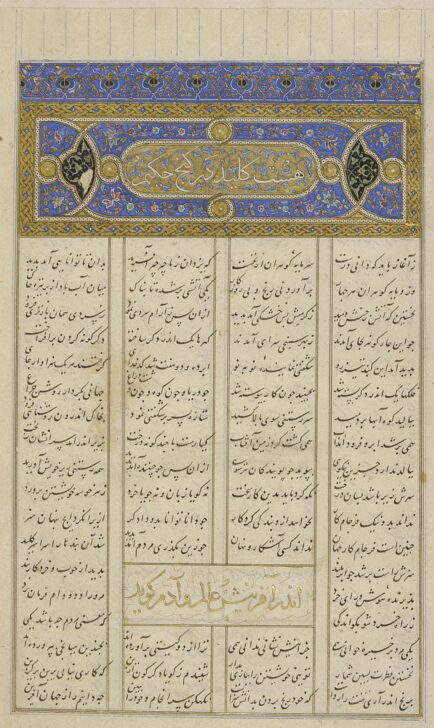Illuminated Chapter Heading from the Shahnama of Firdausi (The “Kervorkian Shahnama”) (Second heading)
Iranian

Description
From the thirteenth century through early modern times, books were the most important material emblem of culture in the advanced civilizations of central Asia. Powerful emperors and warlords built great libraries of works on science (such as astronomy and astrology, herbal lore, and medical texts) as well as poetry, dynastic histories, and copies of the holy Qur’an. As paper was still a rare item and printing had not yet been invented, books were luxury items of the highest order, requiring expensive materials and skilled labor at each step in their making.
This manuscript of the Shahnama, like all other books for the royal libraries of the Timurids, Mughals, and Persians, was copied out entirely by hand. It required great skill and discipline for the calligrapher to sustain the same quality, style, and scale of handwriting page after page.
The language of the Shahnama is Persian, but the script used is a modified form of Arabic, which is written from right to left. The use of gold in the page design testifies to the wealth of the patron and the importance he placed on this project.
———
Maribeth Graybill, Senior Curator of Asian Art
Exhibited in "A Medieval Masterpiece from Baghdad: the Ann Arbor Shahnama"
August 14 through December 19, 2004
Subject Matter:
From the thirteenth century through early modern times, books were the most important material emblem of culture in the advanced civilizations of central Asia. Powerful emperors and warlords built great libraries of works on science (such as astronomy and astrology, herbal lore, and medical texts) as well as poetry, dynastic histories, and copies of the holy Qur’an. As paper was still a rare item and printing had not yet been invented, books were luxury items of the highest order, requiring expensive materials and skilled labor at each step in their making.
This manuscript of the Shahnama, like all other books for the royal libraries of the Timurids, Mughals, and Persians, was copied out entirely by hand. It required great skill and discipline for the calligrapher to sustain the same quality, style, and scale of handwriting page after page.
The language of the Shahnama is Persian, but the script used is a modified form of Arabic, which is written from right to left. The use of gold in the page design testifies to the wealth of the patron and the importance he placed on this project.
Physical Description:
This page from the Shahnama of Firdausi is the second illuminated chapter heading of the book. The language of the text is Persian, but the script used is a modified form of Arabic done in ink, opaque watercolor and gold leaf on paper. The manuscript was made by the Shiraz and Timurid Schools, ca. 1460.
Usage Rights:
If you are interested in using an image for a publication, please visit https://umma.umich.edu/request-image/ for more information and to fill out the online Image Rights and Reproductions Request Form.